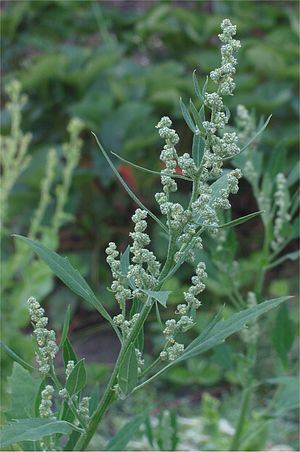シロザ
Chenopodium album/ja
シロザ(Chenopodium album) は、顕花植物のヒユ科に属する成長の速い一年生植物である。一部の地域では栽培されているが、他の地域では雑草と見なされている。一般的な名称には、ラムズクォーターズ、メルデ、グースフット、ワイルドスピナッチ、ファットヘンなどがあるが、これらのいくつかはアカザ属の他の種にも適用されるため、しばしばホワイトグースフットと区別される。
| Chenopodium album/ja | |
|---|---|

| |
| Scientific classification | |
| Kingdom: | Plantae |
| Clade: | Tracheophytes |
| Clade: | Angiosperms |
| Clade: | Eudicots |
| Order: | Caryophyllales |
| Family: | Amaranthaceae |
| Genus: | Chenopodium |
| Species: | album
|
| Binomial name | |
| album | |

| |
| Distribution, from GBIF | |
| Synonyms | |
| |
特徴
本種は当初、直立して生育し、高さは10–150 centimetres (4–59 in)(稀に3 m)に達する。その後、開花後は通常、他の植物に支えられない限り(葉と種の重みで)倒れる傾向がある。葉は互生し、見た目は様々である。株の基部に近い最初の葉は鋸歯があり、およそ菱形で、長さ3-7 cm、幅3-6 cmである。花茎の上部の葉は全縁で披針形菱形、長さ1-5 cm、幅0.4-2 cmである。これらはワックスで覆われ、濡れにくく、粉っぽい外観で、裏面には白い粉状のコーティングがある。小さな花は放射相称で、長さ10-40 cmの密な枝分かれした花序に小さな集散花序として咲く。さらに、花は両性花と雌花であり、外側が粉っぽい5つの花被片を持ち、基部で短く合着している。雄しべは5本である。
類似種
有毒なイヌホオズキは、若い頃は本種に似ているが、C. albumの葉には白い粉状の質感があり、その葉腋には赤い筋がある。
分類
Chenopodium album は複雑な分類を持ち、数多くの小種、亜種、変種に分けられてきたが、それらを区別するのは難しい。以下の変種が『Plants of the World Online』で認められている。
- Chenopodium album var. album – 温帯ユーラシア、インド亜大陸、北アフリカ、エチオピア
- Chenopodium album var. missouriense (アエレン) バセット & クロンプトン(シノニム Chenopodium missouriense アエレン) – アメリカ合衆国東部および中央部
- Chenopodium album var. reticulatum (アエレン) ウオティラ(シノニム Chenopodium reticulatum アエレン) – フランスおよびイギリス
分布と生息地
その自生地は広範な栽培のために不明瞭であるが、ヨーロッパのほとんどの地域を含み、そこからカール・リンネが1753年にこの種を記載した。東アジア原産の植物はC. albumに含まれるが、ヨーロッパの標本とは異なることが多い。『プランツ・オブ・ザ・ワールド・オンライン』によると、この種の自然分布には、西ヨーロッパから中国、ロシア極東までの温帯ユーラシア、インド亜大陸、北アフリカ、エチオピア、米国東部および中央部が含まれる。
その他の地域、例えばアフリカ、オーストララシア、北アメリカ、オセアニアなどにも広く帰化しており、現在では南極を除くほぼすべての場所で、特に荒れ地の窒素が豊富な土壌に生育している。
Cultivation
Regions
The species are cultivated as a grain or vegetable crop (such as in lieu of spinach), as well as animal feed in Asia and Africa, whereas in Europe and North America, it is commonly regarded as a weed in places such as potato fields, while in Australia it is naturalised in all states and regarded as an environmental weed in New South Wales, Victoria, Western Australia and the Northern Territory. While var. album is considered invasive in some regions of the U.S., var. missouriense is native.
Potential impact on conventional crops
It is one of the more robust and competitive weeds, exceptionally capable of colonizing new areas. It may produce up to 50 million seeds per hectare, its seeds remain viable 30 to 40 years in the soil, and it exhibits high phenotype plasticity, modifying its growth form for the conditions it is in. It may be controlled by dark tillage, rotary hoeing, or flaming when the plants are small. Crop rotation of small grains will suppress an infestation. It is easily controlled with a number of pre-emergence herbicides. Its pollen may contribute to hay fever-like allergies.
Pest control
Chenopodium album is vulnerable to leaf miners, making it a useful trap crop as a companion plant. Growing near other plants, it attracts leaf miners which might otherwise have attacked the crop to be protected. It is a host plant for the beet leafhopper, an insect which transmits curly top virus to beet crops.
Uses
| Nutritional value per 100 g (3.5 oz) | |||||||||||||||||||||||||||||||||||||||||||||
|---|---|---|---|---|---|---|---|---|---|---|---|---|---|---|---|---|---|---|---|---|---|---|---|---|---|---|---|---|---|---|---|---|---|---|---|---|---|---|---|---|---|---|---|---|---|
| Energy | 180 kJ (43 kcal) | ||||||||||||||||||||||||||||||||||||||||||||
7.3 g | |||||||||||||||||||||||||||||||||||||||||||||
| Dietary fiber | 4 g | ||||||||||||||||||||||||||||||||||||||||||||
0.8 g | |||||||||||||||||||||||||||||||||||||||||||||
4.2 g | |||||||||||||||||||||||||||||||||||||||||||||
| |||||||||||||||||||||||||||||||||||||||||||||
| Other constituents | Quantity | ||||||||||||||||||||||||||||||||||||||||||||
| Water | 84 g | ||||||||||||||||||||||||||||||||||||||||||||
| †Percentages estimated using US recommendations for adults, except for potassium, which is estimated based on expert recommendation from the National Academies. | |||||||||||||||||||||||||||||||||||||||||||||
Nutrition
Raw lamb's quarters are 84% water, 7% carbohydrates, 4% protein, and 1% fat. In a 100 gram reference amount, lamb's quarters provide 43 kilocalories, and are a rich source (20% or more of the Daily Value, DV) of vitamin C (96% DV), vitamin A (73% DV), riboflavin (37% DV), vitamin B6 (21% DV), manganese (37% DV), and calcium (31% DV), with several other dietary minerals in lesser amounts.
The young shoots may be eaten raw or cooked. The leaves are preferably cooked.
The flower buds and flowers can also be eaten cooked. Each plant produces tens of thousands of black seeds. Quinoa, a closely related species, is grown specifically for its seeds. The Zuni people cook the young plants' greens.
Archaeologists analysing carbonized plant remains found in storage pits and ovens at Iron Age, Viking Age, and Roman sites in Europe have found its seeds mixed with conventional grains and even inside the stomachs of Danish bog bodies.
In India, the plant is called bathua and is found abundantly in the winter season. The leaves and young shoots of this plant are used in dishes such as soups, curries, and paratha – stuffed breads, common in North India. The seeds or grains are used in phambra, gruel-type dishes in Himachal Pradesh, and in mildly alcoholic fermented beverages such as soora and ghanti. In Haryana state, the "bathue ka raita" i.e. the raita (yogurt accompaniment) made with bathua, is commonly eaten in winters.
In Nepal, it is known as bethe or bethu. It is used to make a dish known as saag. The leaves are stir-fried with spices, chilli and diced garlic. A fermented dish known as masaura is also made by dipping the leaves in a lentil batter with spices and then drying them in sun for some days. The fermented masaura can be made into a curry and served with rice.
Animal feed
As some of the common names suggest, it is also used as feed (both the leaves and the seeds) for chickens and other poultry.
Construction
The juice of this plant is a potent ingredient for a mixture of wall plaster, according to the Samarāṅgaṇa Sūtradhāra, which is a Sanskrit treatise dealing with Śilpaśāstra (Hindu science of art and construction).
Ayurveda
In Ayurveda traditional medicine, bathua is thought to be useful for treating various diseases, although there is no clinical evidence such uses are safe or effective.
External links
- Media related to Chenopodium album at Wikimedia Commons
- Data related to Chenopodium album at Wikispecies
| この記事は、クリエイティブ・コモンズ・表示・継承ライセンス3.0のもとで公表されたウィキペディアの項目Chenopodium album/ja(12 July 2025, at 08:05編集記事参照)を素材として二次利用しています。 Lua error in Module:Itemnumber at line 91: attempt to concatenate local 'qid' (a nil value). |